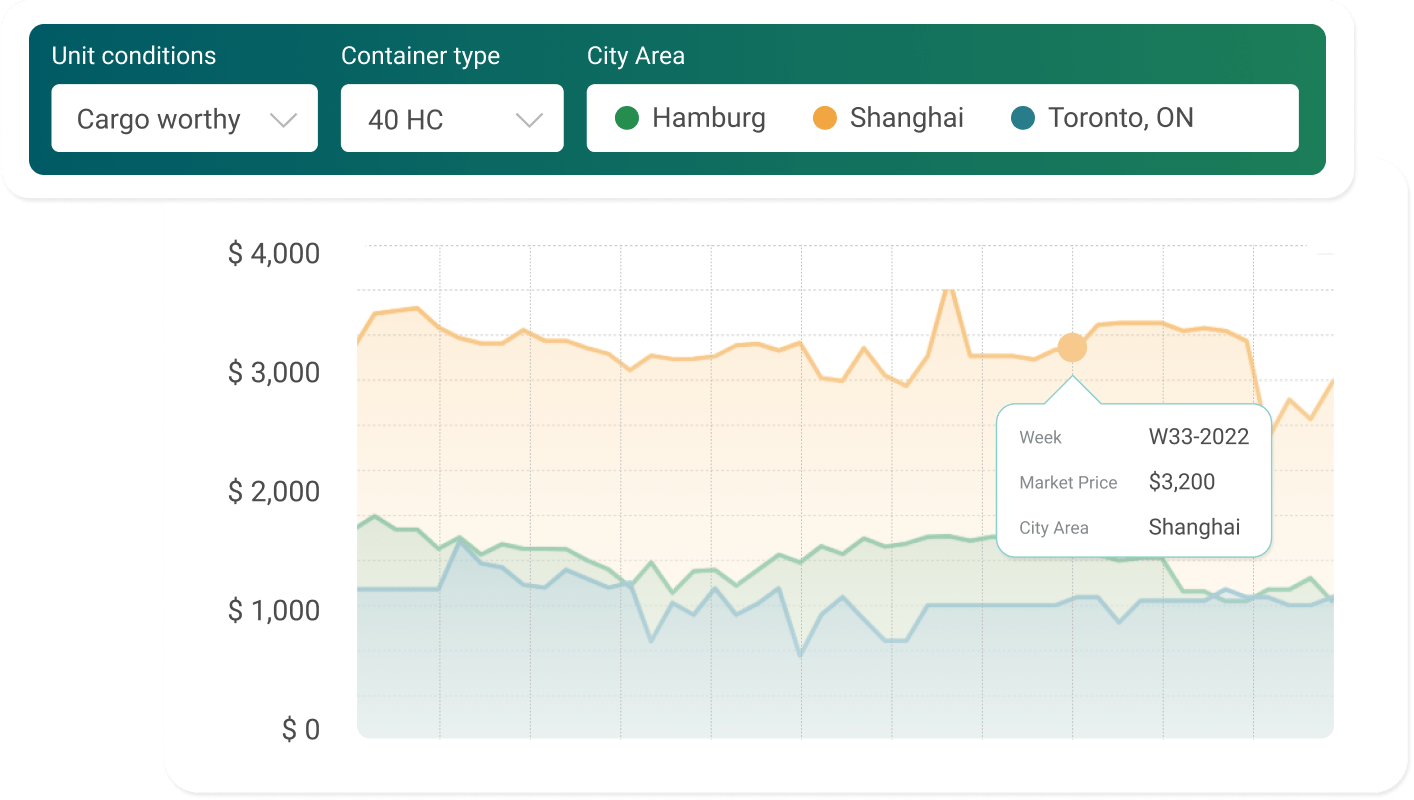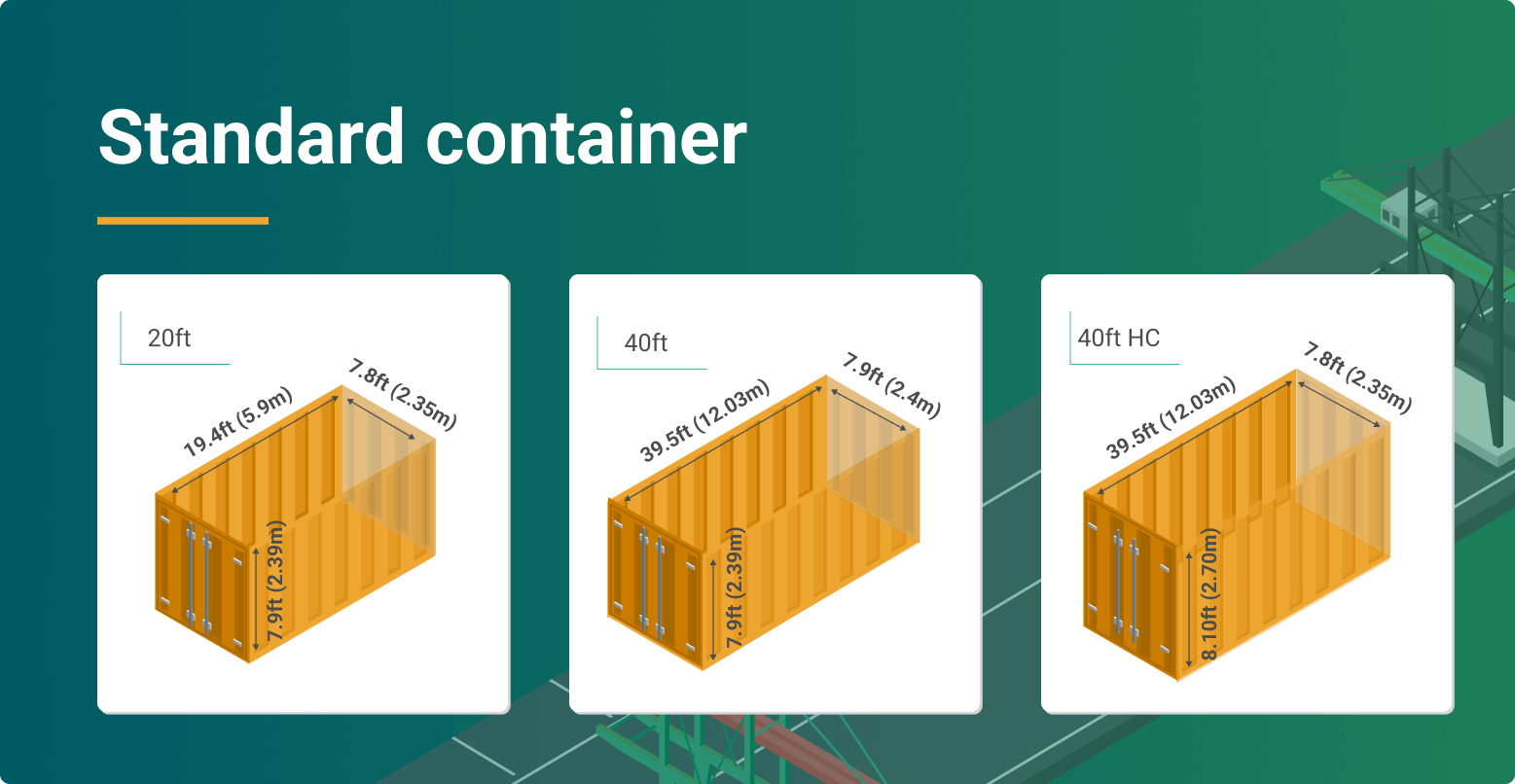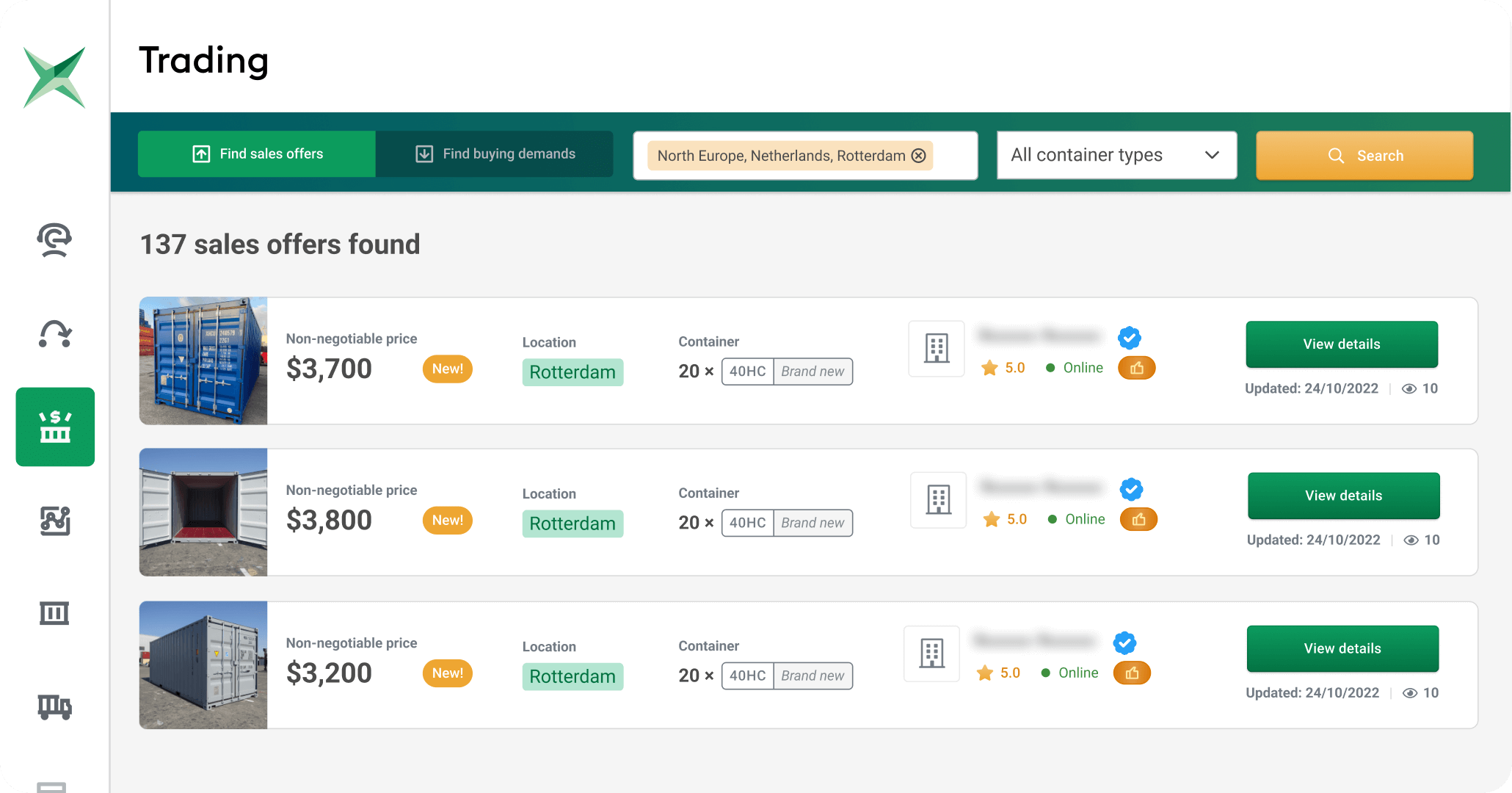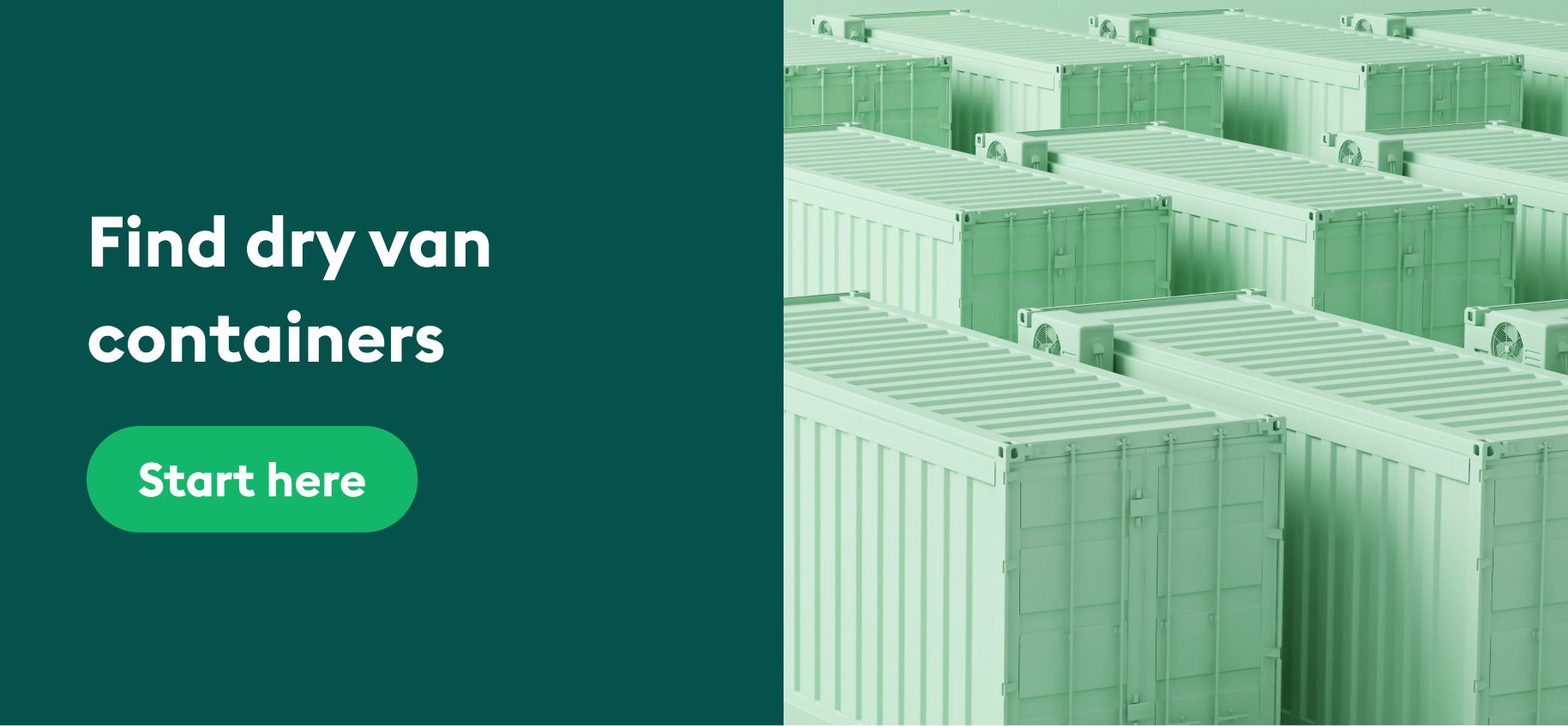If you’re wondering what a dry van container is, and if it’s what you need for your shipments, this blog is your guide. In this piece, we’ll go over the different dry van container sizes and uses. Plus, find out how to get them at the best prices on Container xChange.
Dry containers have a variety of different names, depending on who in the shipping industry is dealing with them, and in what context. One of these names is the ‘dry van container’. Confused? Don’t worry, in this blog, we’ll explain to you exactly what a dry van container is, as well as what it’s used for.
If you’re interested in finding dry containers for your shipping needs, look no further. Container xChange is an online marketplace for trading and leasing shipping containers of all types and sizes. We’ve got over 50,000 containers available in 2,500+ locations around the world.
Curious to see just how easy it is to find what you need at prices you’ll love? Try out our trading search below to see for yourself. Simply input your location and the container type you want, then press ‘search’ to start browsing offers straight away.
Not sure which container type and size you require for your shipments? That’s what this blog is all about! So keep reading to find out which type and size suits your cargo.
What is a dry van container?
‘Dry van container’, ‘dry container (DC)’ and ‘standard shipping container’ are all terms used to describe the exact same thing; a container that transports dry cargo. This includes all goods and products that don’t require special cooling equipment. Here are some common types of dry cargo:
- Paper products
- Clothing
- Grains and dry foods
- Building materials
- Car parts
- Furniture
- Electronics
Dry van containers are made of steel and transport goods via ocean, road and rail. They’re sturdy enough to withstand all kinds of extreme weather conditions at sea. They’re also sealed to prevent wind, rain and excess moisture from damaging the container’s contents.
When buying containers, it’s important to note that there are various container conditions available, including one-trip, cargo-worthy and wind and watertight (WWT). Read more about these conditions in this blog post.
If you need to ship dry goods, there are three main dry van container sizes you can choose from: the 20ft container, 40ft container and 40ft high cube container. We’ll get into more detail on each of these below, so keep reading for the full lowdown.
Dry van container dimensions and sizes
Let’s take a look at the three dry van container sizes now.
20ft dry van container
The 20ft dry container is a popular size for shipping goods of all kinds. Due to its small size, it’s quick to load onto trucks and ships. It’s also easy to handle when shipping via different transport modes or on routes with size restrictions.
The payload capacity of a 20ft dry van container is 25,000kg / 55,126.9 lbs, so if your shipment is under this weight, this nifty container is the perfect choice for you.
Got small shipments you could easily pack into a 20ft dry van container? Click here to check out pick-up charges and container prices for 20ft containers in your location.
40ft dry van container
The 40ft dry van container has double the capacity of the 20ft, so it’s ideal for larger shipments. Not to mention moving machinery or vehicles that won’t fit into a 20ft container.
The best part about 40ft dry vans? They’ve got double the capacity, but you’ll only pay around 30% more for them. Now that’s value for money!
Want 40ft dry van containers for your larger shipments? Check out the price difference between 20ft and 40ft dry van containers in your location right now.
40ft HC dry van container
The 40ft high cube has the exact same floorspace as the 40ft. The only difference is an extra foot of height. This container comes in handy for forwarders with high volume cargo or LCLWhat is less than container load? Less than container load (less than container load, LCL) is a shipping term that refers to the delivery of cargo in smaller quantities than a full container load. A f... More shipments.
With high cubes, you can use fewer containers to transport more goods — another great way to save money.
Interested in browsing 40ft HCs for your LCLWhat is less than container load? Less than container load (less than container load, LCL) is a shipping term that refers to the delivery of cargo in smaller quantities than a full container load. A f... More shipments? Get started right away by clicking here to view offers and compare deals.
Dry van container dimensions
If you need dry van containers for shipping, it’s crucial you know the exact dimensions of the containers and compare these with the volume of your shipment.
Here are the measurements for each container size, so that you can figure out which one is best suited to your needs.
| Measure | 20ft | 40ft | 40ft HC |
| Internal length | 5.9m / 19.4ft | 12.03m / 39.5ft | 12.03m / 39.5ft |
| Internal width | 2.3m / 7.8ft | 2.3m / 7.9ft | 2.4m / 7.9ft |
| Internal height | 2.3m / 7.8ft | 2.3m / 7.9ft | 2.70m / 8.10ft |
| Tare weight | 2,300kg / 5,071.5 lbs | 3,750kg / 8,268.8 lbs | 3,900kg / 8,598 lbs |
| Payload capacity | 25,000kg / 55,126.9 lbs | 27,600kg / 61,200 lbs | 28,600kg / 63,052 lbs |
| Cubic capacity | 33.2 m3 / 1,172 cu ft | 67,7 cu m / 2,389 cu ft | 76.3m3 / 2,694.5 cu ft |
To get all the details on shipping container dimensions for all type’s, take a look at our comprehensive guide. It’s packed with measurements and insights to help you choose the right container for your needs.
How to get up-to-date dry container prices
Now you’ve got the lowdown on different container sizes and their dimensions. But what about how much you should be shelling out for them? It’s important to keep your finger on the pulse so that you know whether you’re getting a good deal or not.
The catch? It can be challenging to get accurate and up-to-date prices for containers, because prices fluctuate constantly.
Luckily, we’ve got the perfect solution for you. Welcome to xChange Insights, a platform where you can track the latest container prices monthly, weekly or even daily.

With Insights, you’ll have access to container prices and pick-up charges in over 180 locations around the world, all on one simple dashboard. It’s also easy to pinpoint the cheapest locations to buy containers in, as well as the most lucrative areas to sell them to make a profit.
Finally, access the latest price trends and industry insights, any time, from anywhere. Want to find out more about Insights, as well as get a sneak peek of the platform and how it works? Get Insights for free today and you’ll be making smart trading moves in no time at all.
Buy dry van containers on Container xChange
So now you understand the different container sizes, plus the types of cargo dry vans can transport. Great! Next on the list: how to source these containers. Let’s go through the four easy steps to buying dry van containers on Container xChange now.
Decide on your criteria
Before you start browsing, make sure you’ve got a clear idea of which container type and size you need for your cargo. Also have some prices in mind, so that you can recognize a good offer when it comes along. Not sure what you should be paying? You can use our Insights tool for this.
Also make sure you know which container condition you prefer for your shipping needs.
Browse offers
Once you’ve got the criteria figured out, type it into the search to start browsing available offers. You’ll be able to compare various options on one dashboard and shortlist the ones that suit you best.
Negotiate a deal
When you’ve settled on an offer, it’s time to negotiate the price, terms and conditions directly with the supplier. This can be done quickly and easily right on the platform. What’s more, there are no middlemen, just you and the partner working out all of the finer details together. It’s so simple!
Make secure payments
The final step? Make safe payments. This can be done using the xChange Wallet. Say goodbye to worrying about whether your transactions are secure or not. You can finally rest easy. Plus, if you have any concerns whatsoever, our financial support team is always more than happy to assist you.
Ready to get started? Great! Here are just some of the benefits you can enjoy as a member of Container xChange:
- 50,000+ containers available in over 2,500 locations
- Work with vetted and reliable partners
- Safe payment handling with the xChange Wallet
- Negotiable prices
- 0% commission on deals
So, what are you waiting for? Let’s get you started with a platform demo with one of our friendly experts right away. Simply click below to find out how you can buy quality dry van containers at the best prices in no time at all.
What is a dry van container?
A dry van container is made from steel, and is used for shipping dry cargo. Dry cargo doesn’t require special cooling equipment, and includes clothing, electronics, paper and grains.
What’s the difference between a dry van and a standard container?
A dry van container and a standard container are the same thing. These terms can be used interchangeably to describe a container used to transport dry goods as opposed to perishable or temperature-sensitive cargo.
What are the dimensions of a dry van container?
Dry van containers are 7.8ft (2.3m) wide, 7.9ft (2.3m) in height, and come in two lengths: 20ft (5.9m) and 40ft (12.03m). These are the most popular container types for shipping dry cargo such as machinery, grains, paper and electronics.





